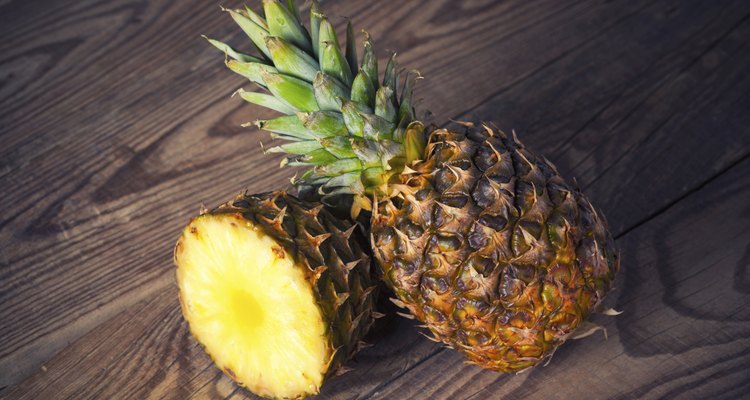
Merydolla/iStock/Getty Images
With its distinctive prickly skin, sprouty green leaves and sweet yellow flesh, the pineapple is a symbol of hospitality as well as a tasty treat. Like many fruits and vegetables, it can be just as nourishing on the body as in the body. Eating mineral-rich pineapple pulp, drinking the juice, and applying both to the body have multiple beauty benefits.
Clearer Complexion
The high vitamin C and bromelain content of pineapple juice make it an effective acne treatment. Bromelain is an enzyme that softens skin and has been used for hundreds of years in South and Central America to fight inflammation and swelling. Drinking pineapple juice helps the body synthesize collagen, which helps skin stay firm and flexible, while vitamin C and amino acids aid in cell and tissue repair. For a double dose of skin nourishment, cut a pineapple in half and refrigerate one half. Scoop the fruit out of the other half, juice it, drink the juice and gently rub the inside of the pineapple skin on your face, avoiding the eye area. After a few minutes, rinse your face thoroughly with tepid water. Repeat two or three days later with the other pineapple half.
Body and Feet Benefits
The same nutrients that make pineapple good for the face also make it beneficial to the rest of your skin. For a gently exfoliating body polish, peel a fresh pineapple and cut the flesh into four wedges. As you shower, rub the wedges all over your body, followed by a cleansing soap and a thorough rinse. A pineapple foot treatment can help slough away flaky and calloused skin, leaving feet smoother and brighter. Start with one-half cup of chopped pineapple, then chop and mix in one-half peeled lemon, one-half unpeeled apple, one-quarter peeled grapefruit, one teaspoon of salt and two teaspoons of anise extract. Rub the mixture all over your feet, giving extra attention to heels, as the skin there tends to harden easily. Wrap your feet in plastic or tie plastic bags over them. After 20 or 30 minutes, remove and rinse. The salt and fruit enzymes help exfoliate and soften skin while the anise -- a licorice extract -- soothes, fights swelling and contains natural healing agents.
Healthy Nails
Brittle and dry nails may signal a vitamin A deficiency, while cracked and split nails may suggest your body's deficiency in B vitamins. Pineapple fruit and juice are good sources of both, another reason to consume them and apply them topically. Hands dry out easily because they are used so much, making nail cuticles more prone to dehydration. dry cuticles cause unsightly nail beds that are also more susceptible to cracking and infection-causing bacteria and fungi. A natural softening treatment for your cuticles is a blend of two tablespoons of pineapple juice and an egg yolk, which counters the drying effect of the enzyme bromelain in pineapple. Apply the mixture to your cuticles and allow it to sit for about five minutes. Use a cotton swab to push your softened cuticles back to their nail beds, then rinse your fingers off with warm water and follow with hand cream. This treatment is just as beneficial to toenails as fingernails.
Tips and Cautions
Generally, fruits and vegetables that nourish skin also indirectly promote nail and hair health, and pineapple is no exception. When using pineapple in a mask or other face product, avoid eye contact because irritation can occur. Pregnant women with gestational diabetes should restrict their intake of pineapple and its juice. Drinking juice from an unripened pineapple can cause diarrhea. Rather than commercial pineapple juice, choose freshly extracted juice because it retains more of the fruit's nutrients, and heat used in commercial processing can destroy the bromelain. For more of pineapple's valuable fiber content, eat the fruit rather than just drinking the juice.
Related Articles

The Best Remedy for Removing Dead Skin ...
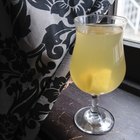
How to Juice Pineapple Skin

How to Cook Mango
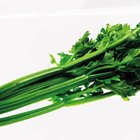
Can You Juice Celery Leaves?
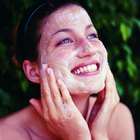
Homemade Anti-Aging Facial Scrub
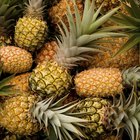
Homemade Glycolic Acid Peel
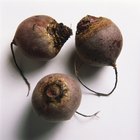
How to Remove Skin From Beets

Can Sweet Almond Oil Be Used to Soften ...

How to Bake Pineapple
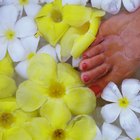
How to Make a Cuticle Exfoliate

Best Fruit Juices to Cleanse the Colon

How to Freeze a Prickly Pear Cactus

How to Remove Nail Glue From Skin
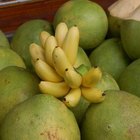
Foods From Rainforest Plants

Bitter Melon for Acne

How to Get Acrylic Off of Cuticles

How to Naturally Treat a Fungal ...

How to Cook With Pineapple Sage

How to Make a Lime Peel Garnish

How to Thicken Raspberry Jam With ...
References
- University of Maryland Medical Center: Bromelain
- CNN.com: Benefits of Pineapple Juice
- "Natural Beauty from the Garden"; Janice Cox: 1999, pages 139-140.
- "Bargain Beauty Secrets"; Diane Irons; 2002, page 135 and 146
- TruthInAging.com: Licorice - Treats More Than a Sweet Tooth
- SFGate: Pineapple Juice Effects
- Drugs.com: Gestational Diabetes DIet
- Drugs.com: Pineapple
- Chicago Tribune: Some health clues are right at your fingertips
- "Hands: The Total Guide To Beauty, Health, Legend & Lore"; Linda Rose: 2001, page 149
Writer Bio
LaMont Jones was an award-winning fashion and beauty editor for a decade at the "Pittsburgh Post-Gazette." A five-time nominator and judge of the CFDA Awards, he covers New York Fashion Week regularly. Jones is a 2011 inductee into the Pittsburgh Fashion Hall of Fame and coaches fashion models.
Photo Credits
Merydolla/iStock/Getty Images